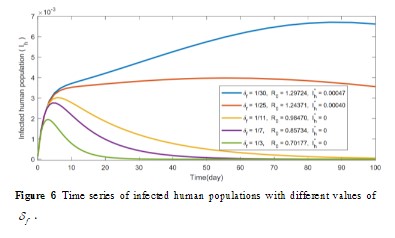Global Stability and Sensitivity Analysis of a Conjunctivitis Epidemic Model in Two Populations with Patient Isolation, Treatment and Insecticide Control
Keywords:
global stability, sensitivity analysis, conjunctivitis, patient isolation, treatment, insecticide controlAbstract
Conjunctivitis (pink eye) is a conjunctive infection. It is caused by viruses, bacteria, or allergies. In this study, we present and analyze a conjunctivitis model that includes the consequences of patient isolation, treatment control, and insecticide control. This SIR-SI (susceptible, infected, recovery - susceptible, infected) model describes disease transmission between humans and fly populations. The proposed model is examined using the standard method. The next generation matrix approach is used to calculate the basic reproductive number. The Lyapunov function is applied to determine the model’s stability. The disease-free equilibrium point (DFE) is global asymptotically stable if , whereas the endemic equilibrium point (EE) is global asymptotically stable if In addition, a sensitivity analysis of the model is performed to determine the significance of model parameters on disease transmission. According to DFE's sensitivity analysis, the effectiveness of patient isolation or human-fly contact prevention is the most sensitive parameter. The numerical results are used to support the theoretical findings. It has been determined that when the effectiveness of patient isolation and recovery of infected humans who visit the doctor increases, the number of infected humans decreases. Furthermore, when the effectiveness of insecticides to protect flies increases, the number of infected flies also decreases.
References
Alkhudhari, Z., AlSheikh, S., & Al-Tuwairqi, S. (2014). Global dynamics of a mathematical model on smoking. International Scholarly Research Notices, 2014, 1–7.
Chowell, G., Shim, E., Brauer, F., Diaz‐Dueñas, P., Hyman, J. M., & Castillo‐Chavez, C. (2006). Modelling the transmission dynamics of acute haemorrhagic conjunctivitis: application to the 2003 outbreak in Mexico. Statistics in medicine, 25(11), 1840-1857.
Diekmann, O., Heesterbeek, J. A., & Metz, J. A. (1990). On the definition and the computation of the basic reproduction ratio R0 in models for infectious diseases in heterogeneous populations. Journal of mathematical biology, 28(4), 365-382.
Elkaranshawy, H. A., Ezzat, H. M., & Ibrahim, N. N. (2021). Lyapunov function and global asymptotic stability for a new multiscale viral dynamics model incorporating the immune system response: Implemented upon HCV. PloS one, 16(10), 1-26.
Heffernan, J. M., Smith, R. J., & Wahl, L. M. (2005). Perspectives on the basic reproductive ratio. Journal of the Royal SocietyInterface, 2(4), 281-293.
Nana-Kyere, S., Banon, D. T., Marmah, S. N., & Kwarteng, D. (2019). Stochastic Optimal Control Model of Haemorrhagic Conjunctivitis Disease. Journal of Advances in Mathematics and Computer Science, 31(3), 1-19.
Ngoteya, F.N., & Nkansah-Gyekye, Y. (2015). Sensitivity Analysis of Parameters in a Competition Model. Applied and Computational Mathematics, 4(5), 363-368.
Samsuzzoha, M. D., Singh, M., & Lucy, D. (2013). Uncertainty and sensitivity analysis of the basic reproduction number of a vaccinated epidemic model of influenza. Applied Mathematical Modelling, 37(3), 903-915.
Sangthongjeen, S., Sudchumnong, A., & Naowarat, S. (2015). Effect of Education Campaignon Transmission Model of Conjunctivitis. Australian Journal of Basic and Applied Sciences, 9(7), 811-815.
Suksawat, J.,& Naowarat, S. (2014). Effect of rainfall on the transmission model of conjunctivitis. Advances in Environmental Biology, 8(14), 99-104.
Thongtha, A.,Modnak, C., & Thakjak, A. (2017). Optimal control for a mathematical model with transmission for house flies. Pibul Research, 28-36.
Thongtha, A., & Modnak, C. (2021). Optimal Control Strategy of Cholera Epidemic Dynamics from Vibrio and Flies Transmission. NU. International Journal of Science,18(1), 15-27.
Uchenna, M., Offia, A., & Kafayat, E. (2019). Control model on transmission dynamic of conjunctivitis during harmattan in public schools. Applied and Computational Mathematics, 8(2), 29-36.
Unyong, B.,& Naowarat, S. (2014). Stability analysis of conjunctivitis model with nonlinear incidence term. Australian Journal of Basic and Applied Sciences, 8(24), 52-58.
Van den Driessche, P., & Watmough, J. (2002). Reproduction numbers and sub-threshold endemic equilibria for compartmental models of disease transmission. Mathematical biosciences, 180(1-2), 29-48.
Viriyapong, R., & Khedwan, N. (2019). Effects of isolation by taking sick leaves of conjunctivitis infected individuals and treatment control on stability of mathematical modeling of conjunctivitis. Science, Engineering and Health Studies, 13(1), 20-28.
Xu, L., Lou, S., & Han, R. (2020). Global Stability for a Semidiscrete Logistic System with Feedback Control. Discrete Dynamics in Nature and Society, 2020,1-7.

Downloads
Published
Issue
Section
Categories
License
Copyright (c) 2024 Journal of Applied Science and Emerging Technology

This work is licensed under a Creative Commons Attribution-NonCommercial-NoDerivatives 4.0 International License.

